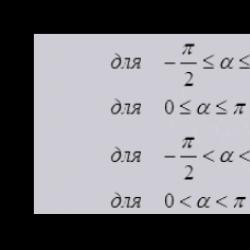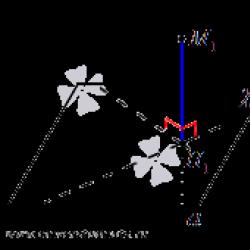What do I know about the force of elasticity. Tasks on the topic “The force of elasticity. Hooke's law" with solutions. Elastic Force and Hooke's Law: Definitions
The elastic force is always the result of the deformation of the body. This force always tries to return the deformed body to its original position. What is the force of elasticity, and under what conditions does it arise?
General characteristic of the elastic force
The elastic force arises when the bodies are deformed, for example, when a spring is stretched or compressed. Deformation is a change in the shape and size of a body.

Rice. 1. The force of elasticity during the deformation of the spring.
If the deformation of the body disappears, then the elastic force will also disappear.
The reason for the emergence of elastic forces are the forces of attraction and repulsion between the particles (molecules or atoms) that make up all bodies. If we slightly increase the distance between the particles, then the interaction forces turn out to be forces of attraction between them. If the distance between the particles is slightly reduced, they become repulsive forces. The elastic force acting on the body is related to the deformation of the body as follows:
where F ex. - the modulus of the elastic force, x - the elongation of the body (the distance by which the initial length of the body changes), k - the coefficient of proportionality, called the stiffness of the spring, measured in N / m. This formula for the elastic force is an expression of Hooke's law. The definition of Hooke's law is expressed as follows: the elastic force that occurs when a body is deformed is proportional to the elongation of the body and is directed opposite to the movement of body particles relative to other particles during deformation.

Rice. 2. The formula of Hooke's law.
A direct proportional relationship between the elastic force and elongation is used in dynamometers - devices for measuring force. Elastic forces work in technology and nature: in clockwork, in shock absorbers in transport, in ropes and cables, in human bones and muscles.
Elastic force properties
Elastic forces include the reaction force of the support and the weight of the body. The reaction force (N) from the side of support on the body arises when the body is placed on some surface (support).
If the body is suspended on a thread, then this same force is called the thread tension (T).
The elastic force has a number of features:
- occur during deformation
- occur simultaneously in two bodies
- perpendicular to the surface
- opposite in direction of displacement.
Body weight (P) is the force with which a body acts on a horizontal support or vertical suspension due to its attraction to the Earth.
Body weight is denoted by the letter P and is measured in Newtons.
If the support of the body is horizontal and motionless, then the weight of such a body is numerically equal to the force of gravity acting on this body and is equal to P=mg
If the body moves upward with acceleration a, then the weight of this body is greater than the weight of the resting body and is equal to $P=(g+a)m$
And if the body with acceleration a moves down, then its weight is $P =(g-a)m$
When the acceleration of the body and the acceleration of free fall are equal, the weight of the body is zero. This is a state of weightlessness.

Rice. 3. Table comparison of the elastic force with other forces.
What have we learned?
The topic "Force of elasticity" is an important stage in the knowledge of physics as a science. Elastic forces are forces that arise in a body during its elastic deformation and are directed in the direction opposite to the displacement of particles during deformation. The elastic force does not exist without deformation of the body. Also, the elastic forces include the reaction force of the support and body weight.
Topic quiz
Report Evaluation
Average rating: 4.4. Total ratings received: 92.
If a load is placed on the middle of a board lying horizontally on two supports, then under the action of gravity for some time the load will move down, bending the board, and then stop.
This stop can be explained by the fact that in addition to the force of gravity directed downwards, another force directed upwards acted on the board. When moving down, the board is deformed, and a force arises with which the support acts on the body lying on it, this force is directed upward, that is, in the direction opposite to gravity. This force is called elastic force. When the elastic force becomes equal to the force of gravity acting on the body, the support and the body stop.
The elastic force is the force that arises when a body is deformed (that is, when its shape and size change) and is always directed in the direction opposite to the deforming force.

The cause of the elastic force
Cause emergence of elastic forces is the interaction of body molecules. Molecules repel at short distances, and attract at large distances. Of course we are talking about distances comparable to the size of the molecules themselves.
In an undeformed body, the molecules are at such a distance at which the forces of attraction and repulsion are balanced. When the body is deformed (under tension or compression), the distances between the molecules change - either the forces of attraction or repulsion begin to predominate. As a result, there is elastic force, which is always directed so as to reduce the amount of deformation of the body.
Hooke's Law
If one weight is hung to the spring, then we will see that the spring has deformed - it has lengthened by a certain amount X . If two identical weights are suspended from the spring, we will see that the elongation has become twice as large. The elongation of the spring is proportional to the force of elasticity.

The elastic force arising from the deformation of the body is proportional to the elongation of the body in absolute value and is directed in such a way that it tends to reduce the amount of deformation of the body.
Hooke's law is valid only for elastic deformations, that is, such types of deformation that disappear when the deforming force ceases to act!!!
Hooke's law can be written as a formula:

where k is the stiffness of the spring;
X- elongation of the spring (equal to the difference between the final and initial length of the spring);
the “–” sign shows that the elastic force is always directed in the opposite direction of the deforming force.
"Varieties" of the elastic force

The elastic force acting on the side of the support is called force of normal support reaction . Normal from the word "normal", that is, the reaction of the support is always perpendicular surfaces.
The elastic force acting on the side of the suspension is called thread tension (suspension) .
Why do bodies on the ground (houses, trees, you and me) not fall through it, although gravity acts on them? Why does a stretched spring or bow tend to regain its shape? You can give answers to these and many questions by getting acquainted in this lesson with another type of force - the force of elasticity.
You already know that all bodies on the surface of the Earth experience its attraction. On any body located on the surface of the Earth or near it, the force of gravity acts. A snowflake falling from the sky is moving towards the Earth. But, falling on the roof, it stops its movement. So something is preventing the snowflake from moving down.
Rice. 1. A snowflake falling from the sky, falling on the roof, stops its movement
What prevents a snowflake and the entire thickness of snow on the roof from moving towards the center of the Earth under the influence of gravity? Answer: the force acting on it from the side of the roof prevents the snow from continuing to move. This force is directed in the direction opposite to the direction of gravity, and numerically equal to it. It compensates for the force of gravity, and the snow behaves as if no bodies were acting on it. In accordance with the already familiar law of inertia, it is at rest.

Rice. 2. The force of elasticity compensates for the force of gravity
Consider another example of gravity compensation. A horizontally located steel tape is fixed on both sides in tripods. If you put a load on this belt, the belt will begin to sag as the load moves down. The tape is deformed. And at a certain amount of deformation of the tape, the load stops. The load moves down until the force acting on it from the side of the steel band balances the force of gravity.

Rice. 3. The curved belt acts on the load with a force that balances the gravity of the load
The force that occurs when a body is deformed is called the elastic force.
Deformations are distinguished by the nature of the change in the shape of the body. This is bending, stretching, compression, torsion, etc.

Rice. 4. Classification of deformations according to the nature of the change in the shape of the body
In addition, the deformation is divided into two types - elastic and plastic. After elastic deformation, the body completely restores its original shape and dimensions.

Rice. 5. An example of elastic deformation
After plastic deformation, the body completely retains the newly acquired shape and dimensions.
This happens, for example, when sculpting from clay or plasticine. Plastic deformation is used in engineering in processes such as forging and stamping.

Rice. 6. An example of plastic deformation
The reason for the emergence of an elastic force is a change in the distances between molecules during deformation and, accordingly, a change in the forces of intermolecular interaction.
|
"Interaction of molecules in tension" With an increase in the intermolecular distance, the forces of intermolecular attraction and repulsion decrease - only the forces of attraction decrease more slowly than the forces of repulsion, therefore, there are total forces and , which are directed towards the intermolecular forces of attraction.
Rice. 7. Interaction of molecules in tension |
|
"Interaction of molecules during compression" With a decrease in the intermolecular distance, the forces of intermolecular attraction and repulsion increase - only the forces of attraction increase more slowly than the forces of repulsion, therefore, there are total forces and , which are directed towards the intermolecular forces of repulsion.
Rice. 8. Interaction of molecules during compression |
If we stretch the body, then the distance between its molecules increases, which means that the force of intermolecular attraction increases. If we try to compress the body, but by doing this we are trying to reduce the distance between the molecules, and then the forces of intermolecular repulsion increase.

Rice. 9. When stretched, the distance between the molecules of the body increases

Rice. 10. When compressed, the distance between the molecules of the body decreases
The deformation of the body is most often very small and not directly visually noticeable. So, when the body is standing on a support (for example, on a table), the deformation of the table is not visible, but it is precisely this that is the reason that the body is motionless, although gravity acts on it.
It is much easier to study the elastic force when the deformation is clearly visible and easily measurable. So, for example, occurs when the springs are stretched. If one, two, three weights are suspended sequentially from the spring, the upper end of which is fixed, then it can be seen that the deformation of the spring increases, and consequently, the elastic force also increases.

Rice. 11. The deformation of the spring increases, and the elastic force also increases
The English physicist Robert Hooke was the first to establish the dependence of the magnitude of the elastic force on the deformation that caused it.

Rice. 12. Robert Hooke (1635-1703)
Hooke found that between the lengthening of the body (an increase in its length l by ∆ l) and the appearance of an elastic force caused by this elongation, there is a simple connection. Here the Greek letter ∆(delta) is used to denote the change in magnitude l.
At small deformations, the elastic force is directly proportional to the elongation of the body:
This statement is called Hooke's law. It is valid only for elastic deformation. Coefficient k is called the rigidity coefficient of the body. It is measured in N/m (newtons per meter).

Rice. 13. Two springs with different stiffness
The figure shows two springs that had the same length before hanging the weights. But the right spring under the action of weights has lengthened more than the left spring under the action of the same weights. This means that the coefficient of rigidity of these springs is different.
In both springs, the elastic force is the same. And if the right spring has lengthened more than the left, then, in accordance with Hooke's law, its stiffness coefficient is less.
The stiffness coefficient describes the elastic properties of the body. It depends on the shape and size of the body, as well as on the material from which it is made.
We found out that under external impact on the body, changes occur in it at the intermolecular level: deformation leads to a change in the distance between molecules. There are various types of deformations. The force that occurs during deformation is called the elastic force. At small tensile (compressive) strains, the elastic force is directly proportional to the elongation of the body.
- Peryshkin A.V. Physics. 7 cells - 14th ed., stereotype. - M.: Bustard, 2010.
- Peryshkin A.V. Collection of problems in physics, 7 - 9 cells: 5th ed., stereotype. - M: Exam Publishing House, 2010.
- Lukashik V.I., Ivanova E.V. Collection of problems in physics for grades 7 - 9 of educational institutions. - 17th ed. - M.: Enlightenment, 2004.
- Internet portal "files.school-collection.edu.ru" ()
- Internet portal "files.school-collection.edu.ru" ()
Homework
Lukashik V.I., Ivanova E.V. Collection of problems in physics for grades 7 - 9 No. 326 - 332.
The force of elasticity is one of the forces of interaction of bodies, and mechanics is studying it. How does it arise, what does it depend on, where is it directed? After reading the article, you will know the answers to these questions.
How and when does the force of elasticity arise?
Let's do an experiment:
- we strengthen the spring with plasticine on the underside of a horizontal surface, for example, a table;
- hang a small weight from the free end of the spring.

Rice. 1. Strength of elasticity
Due to the action of gravity, the load had to fall. Why didn't this happen? The reason is the elastic force that acted on the load from the side of the spring. In the general case, its occurrence is due to deformation: tension, compression, shear, torsion or bending. In our experiment, it arose due to the stretching of the spring.
Direction of elastic force
Every body contains molecules and atoms, which are made up of charged particles. They attract and repel each other with a certain force. Which of these interactions will prevail depends on the distance between them.

Rice. 2. Charged particles
An increase in distance leads to an increase in the action of attractive forces, a decrease in the predominance of repulsive forces. When the body is at rest, both forces are in balance.
From the foregoing, one can unambiguously say why and where the elastic force is directed. Its direction is opposite to the movement of atoms and molecules of the body, since it seeks to restore the original shape of the body.
Interactions between charged particles determine the electromagnetic nature of the elastic force.
Does deformation always lead to the appearance of an elastic force?
Remember how easily the spring restores its shape, but the plasticine always retains it. This happens because of the existence of two limiting cases of deformations. The example with a spring demonstrates the manifestation of elastic, and with plasticine - plastic deformation.
When we talk about the force of elasticity, we mean only elastic deformation. Moreover, its value is small, and it does not last long. Plastic deformation is characterized by other forces. They depend on the rate of occurrence of deformations. They are not studied in the 10th grade physics course.
Relationship between elastic force and deformation
What is the relationship between elastic force and deformation? How to find her? The answers to these questions were found by the English inventor and naturalist Robert Hooke. The results of his experiments showed the linear nature of the relationship. In writing, the law he established is as follows:
Fcontrol=k|Δl| or Fcontrol=k|x|,
Where k- coefficient of elasticity, Δl, or x- absolute elongation.
Δl, or x is the difference between the length of the deformed body and the initial length in meters (m).
k-rigidity. It is expressed in newtons per meter (N/m), and its value is determined by the dimensions of the body and the properties of the material. Unit Fupr- newton (N).
Note that Hooke's law only applies in the case of small elastic deformations.
Any body, when it is deformed and subjected to external influence, resists and strives to restore its former shape and dimensions. This is due to the electromagnetic interaction in the body at the molecular level.
Deformation is a change in the position of body particles relative to each other. The result of deformation is a change in interatomic distances and a rearrangement of blocks of atoms.
Definition. What is elastic force?
Elastic force - a force that occurs during deformation in the body and tends to return the body to its initial state.
Consider the simplest deformations - tension and compression
The figure shows how the elastic force acts when we compress or stretch the rod.
For small strains x ≪ l, Hooke's law is valid.
The deformation that occurs in an elastic body is proportional to the force applied to the body.
F y p p = - k x
Here k is a proportionality factor called stiffness. The SI unit of stiffness is Newton per meter. Rigidity depends on the material of the body, its shape and size.
The minus sign shows that the elastic force opposes the external force and tends to return the body to its original state.
There are other forms of writing Hooke's law. The relative deformation of the body is the ratio ε = x l. The tension in the body is the ratio σ = - F y p p S . Here S is the cross-sectional area of the deformed body. Second formulation of Hooke's law: relative strain is proportional to stress.
Here E is the so-called Young's modulus, which does not depend on the shape and size of the body, but depends only on the properties of the material. The value of Young's modulus for different materials varies widely. For example, for steel E ≈ 2 10 11 N m 2, and for rubber E ≈ 2 10 6 N m 2
Hooke's law can be generalized to the case of complex deformations. Consider the bending deformation of the rod. With such a bending deformation, the elastic force is proportional to the deflection of the rod.

The ends of the rod lie on two supports, which act on the body with a force N → , called the normal reaction force of the support. Why normal? Because this force is directed perpendicular (normally) to the contact surface.
If the rod rests on a table, the normal reaction force of the support is directed vertically upwards, opposite to the force of gravity that it balances.
The weight of a body is the force with which it acts on a support.
The elastic force is often considered in the context of stretching or compressing a spring. This is a common example that often occurs not only in theory but also in practice. Springs are used to measure the magnitude of forces. The device designed for this is a dynamometer.
A dynamometer is a spring whose tension is calibrated in units of force. A characteristic property of springs is that Hooke's law is applicable for them with a sufficiently large change in length.
When the spring is compressed and stretched, Hooke's law applies, elastic forces arise that are proportional to the change in the length of the spring and its stiffness (coefficient k).
Unlike springs, rods and wires obey Hooke's law within very narrow limits. So, with a relative deformation of more than 1%, irreversible changes occur in the material - fluidity and destruction.
If you notice a mistake in the text, please highlight it and press Ctrl+Enter








